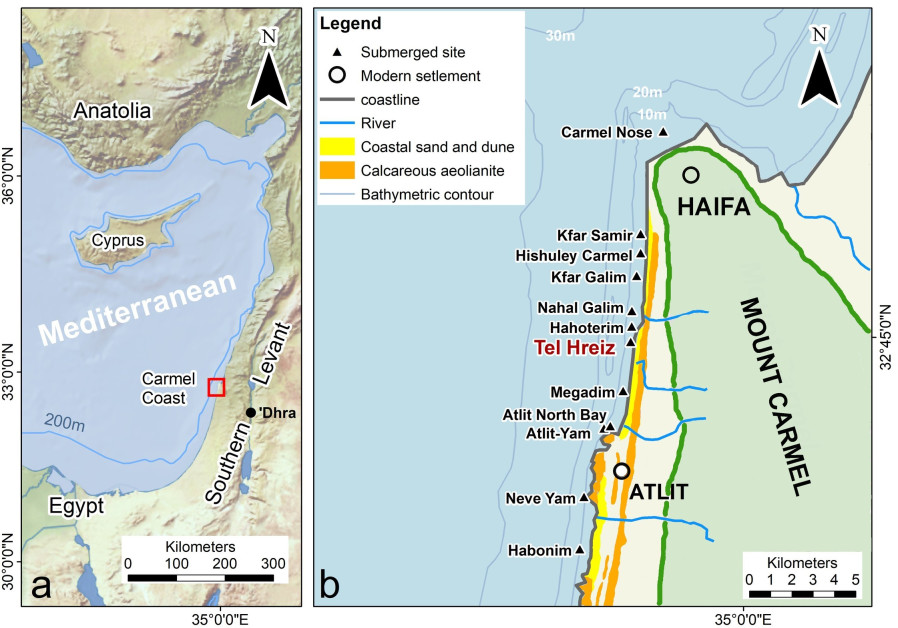7,000-year-old wall against sea level rise uncovered on Carmel Coast
The researchers cautioned that the fate of 7,000-year-old Tel Hreiz should represent a warning for present-day humans.
By ROSSELLA TERCATIN
Some 7,000 years ago, a village on the Carmel Coast built a wall to protect itself from the rising sea level caused by melting glaciers, joint research by Israeli and Australian scholars has uncovered.
Researchers from the University of Haifa, Flinders University in Australia, the Hebrew University of Jerusalem and the Israel Antiquities Authority discovered the remains of the most ancient defense structure against the rising of the seas so far known in human history.
However, the endeavor of the inhabitants of Tel Hreiz eventually failed and the village was submerged, as explained in a study published on Wednesday in PLOS ONE, a scientific journal that describes itself as multidisciplinary “inclusive journal community working together to advance science for the benefit of society.”
Tel Hreiz dates backs to the Neolithic age, which began around 10,000 years ago and represented the concluding stage of cultural evolution among prehistoric people – who started to reside in permanent settlements – according to the Encyclopedia Britannica.
“We are talking about an agricultural community of 20 or 30 families or 100/150 people,” marine archaeologist co-author of the article Ehud Galili from the Zinman Institute of Archaeology, University of Haifa, told The Jerusalem Post. “They grew wheat, raised livestock, including cattle and pigs, and also fish.”
Originally the village was built on at an elevation of about 3 m. above sea level.

Galili explained that the choice to live on the cost offered advantages – the opportunity to exploit both terrestrial and marine resources – but also disadvantages, and specifically the need to adapt to a challenging environment, since, during the Neolithic period, Mediterranean populations experienced a sea-level rise of 4 to 7 mm. a year or approximately 12-21 cm. during a lifetime (up to 70 cm. in a 100 years),
“Winter storms caused more and more damage. The community of Tel Hreiz proved to be resilient enough to come together, assess the situation, conceive a plan to solve the situation and carry it out,” he added.
The wall was about 100 meter-long and built from boulders weighing around one ton each, which required a team of people to move them. For other structures, the villagers used smaller stones.
“The wall worked for some years, maybe 10 to 30, but eventually it was not enough and Tel Hreiz was abandoned and flooded,” Galili further said.
The life spam of the village was about 200 years.
“There are no known or similar built structures at any of the other submerged villages in the region, making the Tel Hreiz site a unique example of this visible evidence for human response to sea-level rise in the Neolithic,” Jonathan Benjamin from Flinders University explained in a statement, adding that the discovery was made possible after natural processes exposed new areas of the site.
According to the statement, the archaeological excavation and studies were carried on behalf of the Israel Antiquities Authority from 1989 to 2017, as part of the management of the underwater cultural heritage, and on behalf of the University of Haifa from 1983-1988, and from 2017-2019.
The project was carried out with the support of the Honor Frost Foundation.
The finds are curated in the Israel Antiquities Authority storage facilities in Caesarea and Beit Shemesh.
The researchers cautioned that the fate of Tel Hreiz is a warning for present-day humans. They explained that the position and situation of the ancient site are comparable to the ones of modern Jakarta, Indonesia’s capital, with a population of over 10 million people.
“Modern sea-level rise has already caused lowland coastal erosion around the world. Given the size of coastal populations and settlements, the magnitude of predicted future population displacement differs considerably to the impacts on people during the Neolithic period,” Benjamin said.
Today Tel Hreiz is located at a depth between 0 and 4 meters below the waves, and stretches out 100 m into the sea.
“We have been studying Tel Hreiz for 50 years. In total, there are 14 submerged sites in Israel. The further they are located from the coastline, the more ancient they are,” Galili explained to the Post. “After every storm, we go back to see what new material was exposed.”
Content retrieved from: https://www.jpost.com/Israel-News/Unique-7000-year-old-wall-against-sea-level-rise-uncovered-in-Israel-611329.